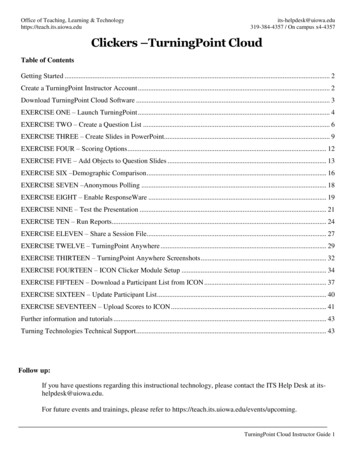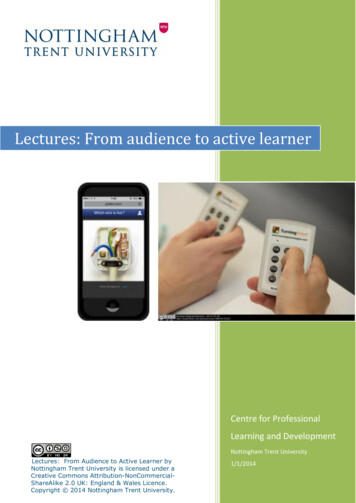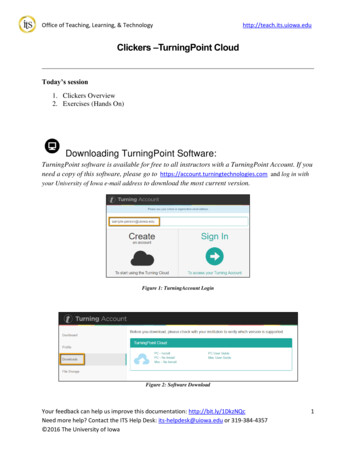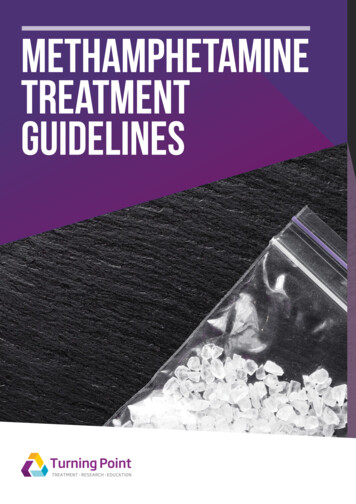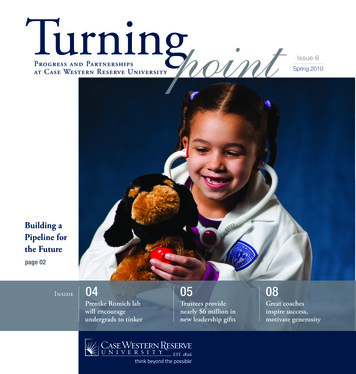
Transcription
TurningpointProgress and Partnershipsat Case Western Reserve UniversityIssue 6Spring 2010Building aPipeline forthe Futurepage 02Inside040508Prentke Romich labwill encourageundergrads to tinkerTrustees providenearly 6 million innew leadership giftsGreat coachesinspire success,motivate generosity
2aPipelinefor the Future3THE JOAN C. EDWARDS CHARITABLE FOUNDATION MAKESMULTIMILLION-DOLLAR, MULTI-YEAR COMMITMENTCase Western Reserve University will beAs part of the effort, members of the Case Western Reserve community and physicians atan essential partner in a medical educationUniversity Hospitals Case Medical Center will provide academic programming and individualpipeline created and supported by thementoring to students at CSSM.Joan C. Edwards Charitable Foundation.The Joan C. Edwards Charitable Foundation was created by a bequest from the Joan C.The first phase of the Joan C. EdwardsEdwards Trust in 2006 at the time of her death. Edwards was a philanthropist and former jazzCharitable Foundation Health Professionsinger. Her husband, James, who died in 1991, was owner and CEO of National MattressPipeline Program is the creation of theCompany in Huntington, W.Va., where the couple lived most of their lives.Edwards Scholarship Endowment at CaseWestern Reserve. An initial investment of 10 million to 12 million over 10 yearswill establish an endowment for full-tuitionscholarships for students to earnbachelor’s and medical degrees atCase Western Reserve.Beginning in 2011, the Health ProfessionPipeline Program will provide this scholarship opportunity to one student per yearfrom the Cleveland Metropolitan SchoolDistrict’s Cleveland School of Science andMedicine at the John Hay Campus (CSSM).The foundation considered Cleveland to be an ideal candidate for this program because ofthe presence of a science and medicine school like CSSM at the John Hay Campus and theschool’s proximity to nationally ranked Case Western Reserve, its School of Medicine and UHCase Medical Center. It also was drawn to the area because the U.S. Department of Healthand Human Services designated many surrounding Cleveland neighborhoods as HealthProfessional Shortage Areas.“Mrs. Edwards believed deeply in the importance of giving underrepresented minority andlow-income students greater opportunities to become physicians and that they, in turn, couldprovide medical care to underserved populations,” says Thomas M. McDonald, Clevelanddistribution director for the Joan C. Edwards Charitable Foundation. “The foundation believesthese goals will be best achieved by enabling partners in public schools, university educationand health care to build on their already strong collaborative relationships.”The program has the potential to educateThe foundation hopes the Cleveland pipeline program will be a successful model for98 doctors from traditionally underrepre-others nationwide.sented minorities and low-incomebackgrounds over the next 60 years.“Case Western ReserveCSSM students (top left) celebrate the scholarship announcement at the John Hay CampusWhite Coat Ceremony.School of Medicine students (lower left) already serve as mentors to CSSMstudents—a key component in the pipeline program’s future success.Brian (top right, on left) and Thomas M. McDonald of the Joan C. EdwardsCharitable Foundation are recognized for their commitment to the university.University is honoredto be a part of thisvisionary pipelineproject. One of ourcore values is diversity,and this programprovides a wonderfulopportunity to supportpromising students andat the same time meeta critical societal need.” President Barbara R. Snyder
45a Place toTinkerCase Western Reserve UniversityPrentke Romich Company with Edwin Prentke (CIT ’26), whom he memorializes through thishas received a 1 million gift fromgift. Among the new firm’s early projects were a device to limit the acceleration of poweredBarry A. Romich (CIT ’67) to create thewheelchairs and the first communication device for stroke victims.Prentke Romich Laboratory at theCase School of Engineering.“I want today’s undergraduates to havea place to go to build things,” saysRomich, who got his own start in handson engineering by “tinkering” in the studentshop of Bingham Hall in the ’60s. His“It was a blessing to know Ed. He had the business experience, and I had the recent formaltechnical training,” Romich recalls. “We both had the ability to put ourselves into the place ofthe individuals we were serving.Headquartered in Wooster, Ohio, the company completed the process of ownership transitionto an employee stock ownership plan in 2008. Romich has since used the Romich Foundationas a vehicle to support responsible charitable distribution of his previously owned stock.work was the beginning of what is nowIn addition to his desire to pay tribute to Prentke, Romich was inspired by the leadership gifta leading international manufacturerof Case Western Reserve Trustee Larry M. Sears (CIT ’69) and Sally Zlotnick Sears (FSM ’72,of assistive technology to address theLYS ’74), whose nearly 6 million gift to the Case School of Engineering in 2006 enabled thecommunication needs of people withcreation of the Sears Undergraduate Design Laboratory.severe speech disabilities.Romich also wanted to give something back to the university and to show his support forIn 1966, while a student at the Case Institutethe leadership of President Barbara R. Snyder. “I’m so pleased that such a place as Caseof Technology, Romich co-founded theWestern Reserve exists,” Romich says. “I hope this space inspires talented young studentsFive Trustees PledgeMore Than 6 Million toCase Western Reserve UniversityAto go on to do great things.”t the February Board of Trustees dinner, Chair Charles “Bud” Koch announced a totalof more than 6 million in new leadership gifts from five Case Western Reserve UniversityN. Linsalata (CIT ’63) and his wife, Jocelyne;trustees. While individual donors have chosen to remain anonymous, the impact of their 5 million from incoming board Chair Kochcollective philanthropy on student, faculty and programmatic support will be evident onand his wife, Katie; 7.5 million from Trusteecampus for generations to come.Chuck Fowler (MGT ’90) and his wife, Char;“Like so many of our alumni and friends, our trustees are inspired every day by theoutstanding students and faculty at Case Western Reserve,” Koch says. “These trustees’generosity is a shining example to others of the value of supporting an institution thatimproves lives through excellence in education and research.”Barry A. Romich (left) withPresident Barbara R. Snyder; Norman C.Tien, dean of the Case School of Engineeringand Nord Professor of Engineering; and CaseWestern Reserve Trustee Larry M. Sears. 3 million from outgoing board Chair FrankThe gifts build upon the fundraising success at Case Western Reserve that has been growingsince Barbara R. Snyder’s investiture as president in 2007. In fiscal year 2008–09, theuniversity raised 108 million in new gifts and pledges, the second-highest total in its history.These gifts also follow major trustee announcements in the past several years, includingand nearly 6 million from Trustee Larry M.Sears (CIT ’69) and his wife, Sally ZlotnickSears (FSM ’72, LYS ’74).“I often say that our trustees know us best,”Snyder says. “When these leaders invest inCase Western Reserve, they send a powerfulmessage to the broader community aboutthe progress we’re making. I am very gratefulfor their support.”
67Celebrations:Winter HighlightsWith the academic year in full swing and snow blanketing the Case Western Reserve University campus,President Barbara R. Snyder and faculty members celebrated groundbreaking advancements at home and onthe road. Nearly 200 alumni and friends came together for a celebration of orthopaedic innovation in Naples, Fla.,while campus events featured inaugural professorships and continuing legacies.Clare M. Rimnac, PhD (left), associate deanof research at the Case School of Engineering and Wilbert J.Austin Professor of Mechanical and Aerospace Engineering,and university friend Marilyn J. Tsivitse discuss advancementsin bone and joint restructuring at the Naples event.President Barbara R. Snyder (center) enjoys the Naples “BreakthroughResearch” event with hosts Case Western Reserve Trustee Chuck Hallberg (LAW ’77) and hiswife, Sharon.Adel (Tony) Saada, PhD, an emeritus professor of civil engineering at the Case Schoolof Engineering, and his wife, Nancy Saada (GRS ’72) (left) meet Thrity Umrigar, an associateprofessor of English and author of The Weight of Heaven, during a Faculty Spotlight Series receptionat Harcourt House.Peter Holmes (center) and his wife, Judy, join Robert H. Miller, PhD, the Allen C.Holmes Professor in Neurological Diseases, at a dinner highlighting neurosciences research.Holmes says that 20 years after his father’s death, his legacy lives on through Miller’s pioneeringwork on the biology of neural diseases and through the professorship that bears his name.Conor P. Delaney (center), his wife,Clare, and their children celebrate his appointmentas the inaugural Jeffrey L. Ponsky, MD, Professor ofSurgical Education.
89New ChairHonors AlumnaeEddie FinniganBob Del RosaNancy Graythe Courage to ExcelBill SudeckALUMNI SHOW GRATITUDE FOR COACHES’ SUPPORTEvery season, football coach Eddie“Being involved in athletics was one of the most enjoyable parts of my undergraduateFinnigan posted a mantra on his players’experience,” Wyant says. “I hope that having the track bear Coach Sudeck’s name willlockers. It read: “It is very easy to be ordinary,motivate today’s students to do their best.”but it takes courage to excel. And we mustJames B. Treleaven, PhD (CIT ’69, GRS ’90), chair of the university’s Alumni Association,excel.” Jay Schnackel (ADL ’62) says thesays the inspiration and friendship demonstrated by his wrestling coach, Bob Del Rosa, hascatchprase proudly hangs on the wall oflasted a lifetime.his home, reminding him of the tenacity hiscoach instilled in him so many years ago.Like Schnackel, many alumni whoparticipated in athletics at Case WesternReserve University say that sports definedtheir college experience. The coaches whoinspired their success live on in lessonslearned and gifts made in their honor.One such display of generosity came in2008, courtesy of James C. Wyant, PhD (CIT’65), a university trustee and former captainof the cross-country team, who named CaseWestern Reserve’s track in honor of CoachBill Sudeck.“When my daughter made the cheerleading squad at Ohio State, Del Rosa was one of thefirst to call and congratulate her,” he says. “He doesn’t lose track of the athletes he coaches.He really cares.”No stranger to a coach’s compassion, Billie J. Navojosky, PhD (FSM ’72) remembers thetireless efforts of Nancy Gray. Before Title IX began to ensure equal access to resources, Graydrove the women’s basketball team to away games in her own car and helped raise fundsfor the team’s first uniforms.“She taught us to be winners no matter what the obstacles,” Navojosky says. “Shehad a commitment to move mountains, to blaze a trail for future women athletes atCase Western Reserve.”Today, Case Western Reserve offers 19 varsity sports, and in any given year, as many as 500students participate in varsity athletics. As Schnackel, Wyant, Treleaven and Navojosky knowwell, the inspiration of their coaches and the support of alumni and friends can help preparethese young athletes for lifelong success.ifelong social workers and friends,advance human services. Their support,Leona Bevis (SAS ’43) and Margueritecombined with a significant anonymousHaynam (FSM ’30, LYS ’31, SAS ’41)gift from a committed champion of socialundoubtedly will be remembered forservice research, rounded out the originaltheir work on behalf of the people offunding from Bevis and Haynam.Cleveland. And their commitment to thenext generation of social workers will liveon in a new endowed chair that bears theirnames. Their combined estate gifts—theresult of dedicated service on the front linesof community development—will foreverbenefit Case Western Reserve Universitythrough the Leona Bevis & MargueriteHaynam Professorship in CommunityDevelopment at the Mandel School ofApplied Social Sciences.Attorney William D. Ginn, a past president ofthe Welfare Federation, now known as theCenter for Community Solutions, knew andworked with both Bevis and Haynam. Hecalls the duo “visionary leaders in the socialservice community.”“They each brought to their work highlevels of professional competence andinsight that resulted in positive changesin the Cleveland community, especially inservices to families and children,” Ginnsays. “Their leadership was catalytic.”Images property of Case Western Reserve University Archives.LThe Frank and Nancy Porter familyalso provided an endowed scholarship insupport of the fund. “Our familyis honored to memorialize the lives andvisions of Leona and Marguerite. Theywere dear friends of my family, but, evenmore, they were steadfast advocates forthe people of Cleveland,” Elizabeth PorterDaane (SAS ’91) says.Bevis was the first female executivedirector of the Welfare Federation ofCleveland. She gave back to her almamater as a volunteer fieldwork supervisor,a member of the visiting committee and amentor to students and alumni. Haynamwas the executive director of the TravelersAid Society and a former faculty member atthe Mandel School.“Because of this professorship, idealsthat Leona and Marguerite so stronglyadvocated—like upholding the rights ofthe disenfranchised and furthering appliedresearch to match charity with need—The women’s gifts ignited an outpouringwill forever be represented at the Mandelof support from old friends and peers,School of Applied Social Sciences,” sayswho supplemented the women’s effort toGrover C. Gilmore, dean of the school.The legacies of alumnae LeonaBevis (top) and Marguerite Haynam(middle) will live on through aprofessorship in community development.
1011Good NewsA selection of recent gifts from around campusProfile:Robert J.Herbold, PhDAs a member of Case Western Reserve University’s Board of Trusteesfor nearly a decade, Robert J. Herbold, PhD (GRS ’66, ’68) says it was hisCase Western Reserve University has received a 250,000 challenge grant fromduty to “look out for the long-term health of the university and help steer itJohnson & Johnson Services Inc. through the Johnson & Johnson Corporateaccordingly.” Today, Herbold continues to guide the university towardOffice of Science and Technology (COSAT) and its affiliates. The university will utilize thissuccess with his support of technological innovation.research grant to support science, medicine and engineering projects to improve humanPrior to his role as executive vice president and chief operating officer ofhealth and will match or possibly exceed COSAT’s commitment in support of theseMicrosoft Corporation from 1994 to 2001, Herbold spent 26 years at Procterprojects. The agreement with COSAT is modeled after the Coulter-Case Translational& Gamble. He served as senior vice president of marketing for the last five.Research Partnership that has been instrumental in promoting translational researchHe says his business sense and corporate background have taught himon campus.that the future of America’s economy hinges on its ability to competetechnologically. Herbold says that is why he and his wife, Patricia, haveprovided scholarship support to more than 30 science, math and engineeringmajors over the past six years and why the couple created the Robert J.The Burton D. Morgan Foundation has granted 100,000 to Case WesternHerbold Professorship in Biomedical Engineering.Reserve to provide students with real-world experiences in design, innovation andcommercialization. The grant from the Hudson, Ohio-based foundation will fund a new“The United States is not producing enough talent in technological fieldsstaff position—the liaison for student innovation and entrepreneurial projects—to placeto sustain the development of the economy,” Herbold says. “We needstudents as commercialization assistants with researchers, companies and early-stageinnovation. And biomedical engineering at Case Western Reserve is ripeinvestment firms. The liaison will work within the university’s established programs,with possibilities.”including the Science and Technology Entrepreneurship Program (STEP), The InstituteThe Herbold Chair supports the research of David Wilson, PhD, whosefor Management and Engineering (TiME) and Case’s Rising Engineers and Technologicalwork Herbold calls “unbelievable.” Wilson is the inventor of cryo-imaging,Entrepreneurs (CREATE).a biomedical imaging system that delivers incredibly detailed images,The author of two books on businessAlumnus Kathleen L. Barber, PhD (GRS ’68) has endowed a graduate fellowship at theCollege of Arts and Sciences. The Kathleen L. Barber Fellowship for GraduateStudents in Political Science is intended to assist women pursuing graduate studies.Barber hopes the fellowship will encourage more women to become academic leaders inteaching, scholarship and civic involvement.success, Herbold now serves as managing director of theHerbold Group LLC, a consulting business focused onissues of profitability, strategy and operations.making it possible to visualize an entire image in microscopic detail or topinpoint a single cell.“My team and I are collaborating with other researchers to apply this newtechnology in studies of cancer, cardiovascular disease and genetics,”Wilson says. “With the generous support of the Herbolds, I hope we continueto break new ground in biomedical engineering.”
1213UniversitytheServingTWhy I Give“ I owe a large partof my personal andprofessional successto the law school.That will always bea primary anchorand obligation.his winter, Case Western Reserve University welcomed four new members to the Boardof Trustees.Charles E. HallbergCharles E. Hallberg (LAW ’77) founded MemberHealth LLC, in Solon, Ohio, which has grown”into a leading prescription benefit management company. MemberHealth now operates asa subsidiary of Universal American and is an integral part of Universal American’s “HealthyCollaboration” model for health care.W. Nicholas “Nick” HowleyIndustrial executive W. Nicholas “Nick” Howley is chair and chief executive officer ofTransDigm Group Inc. and TransDigm Holdings, which owns and operates a wide range ofproprietary aerospace component manufacturing businesses.Hemant Kanakia, PhDHemant Kanakia, PhD (GRS ’80) is a technology venture capitalist who has been a partnerwith Columbia Capital LLC in Alexandria, Va., since 2004. He plans to focus on makinginvestments overseas from his own investment fund, Kanakia Ventures LLC. George Aronoff(ADL ’56, LAW ’58)Case Western Reserve University holdsGeorge, a senior partner of the law firm Benesch, Friedlander, Coplan & Aronoff. He alsoAronoff family.praises his liberal arts education at Adelbert, saying, “I’m a great believer in the university—Though they knew each other in high school,what it has done and what it is doing.”it was during their undergraduate years atThe Aronoffs have demonstrated their confidence in their alma mater throughAdelbert and Flora Stone Mather colleges,volunteer participation and annual fund and leadership gifts. Their relationship withrespectively, that George (ADL ’56, LAW ’58)the university has been going on, as George says, “for a long, long, long time.”and Roma (FSM ’56) Aronoff dated and wed.Continuing in their footsteps, their sons, Jim(LAW ’84) and Steve (LAW ’86), were eachJames C. Wyant, PhDintroduced to their wives as law students atA former student-athlete who majored in physics, James C. Wyant, PhD (CIT ’65) is deanBut it is much more than its romantic lureof the College of Optical Sciences at the University of Arizona, one of the world’s foremostthat makes Case Western Reserve importantteaching and research programs in optics. In 2002 he co-founded the 4D Technologyto George and Roma.Corporation and currently serves as its board chair.“It allowed me to accomplish what I’ve been able to accomplish in the legal world,” saysa special—and very heartfelt—place in theCase Western Reserve.George is an emeritus trustee and a member of the School of Law’s visiting committee.Roma, whose undergraduate class was instrumental in the founding of the university’s FloraStone Mather Center for Women, was a member of the college’s alumnae board. Among thecouple’s philanthropic activities at the university is the endowment of the Law Review—theSchool of Law’s student-edited, scholarly publication.“George was an editor of the Law Review when he was a student, and both our sons wereinvolved with it, too,” Roma says.She adds that she and her husband will forever be grateful to the university where they metalmost 54 years ago. “We owe Case Western Reserve a lot,” she says.
1415Financial Spotlight:LIFE INSURANCE POLICY ENSURES CONTINUEDACCESS TO MENTAL HEALTH SERVICESHOW DO THEY WORK?In addition to the protection it can afford families at their time of need, life insurance canbe leveraged to help donors leave their legacies at Case Western Reserve University.n the 1960s, when in-patient psychiatric facilities were quicklyA charitable contribution of a life insurance policy offers a number of practicalfilling, L. Douglas Lenkoski, MD (MED ’53) focused on bringingadvantages, and special provisions can be made to protect the donor’s spouse ormental health services out of the hospital and into the community.children. By naming Case Western Reserve as the beneficiary of a life insurance policyLenkoski was a driving force in the public psychiatry movement,or by naming the university as the policy owner through an irrevocable gift, donors canwhich advocated policy changes to ensure that patients hadenjoy specific tax advantages.access to mental health services within their neighborhoods.For the annual cost of a whole-life policy premium, donors can provide the universityHe would later become chair of the Department of Psychiatrywith a substantial future benefit—perhaps far more than they could normally give—withoutduring his 30-year career at Case Western Reserve Universityimpairing other assets intended for family members. For those who transfer ownershipSchool of Medicine.of the policy to the university, future premium payments are deductible. In addition, the“It’s my personal belief that everyone, regardless of his or heramount of the commitment is fixed, rather than subject to market fluctuations, andstation in life, should have adequate access to mental healthinsurance proceeds are not subject to the delays and costs of the probate process.care, and that’s what I have devoted a good part of my careerto,” says Lenkoski, a long-time member of the Cuyahoga CountyTo learn more about making a gift of life insuranceCommunity Mental Health Board.to Case Western Reserve, please contact John F.For his tireless humanitarian efforts, his profound respect forpatients, and his devotion to the education of students andresidents, Lenkoski’s colleagues, peers and community membersinitiated the school’s L. Douglas Lenkoski Professorship inPsychiatry in his honor. Lenkoski has since supplemented theprofessorship by naming Case Western Reserve as the owner andbeneficiary of his life insurance policy.“The School of Medicine was very good to me, and I feel it isincumbent upon me to give back,” he says. “I hope that byexposing medical students to public psychiatry, I can continueefforts to help Cuyahoga County’s mentally ill.”Shelley, executive director of planned giving, at“216.368.4460 or giftplan@cwru.edu.Through this life insurance policy,I’ll be able to help get studentsinterested in public psychiatry,bringing mental health services tothe people who need them most.ABOUTIGifts of Life Insurance:TurningPointTurning Point: Progress and Partnerships atCase Western Reserve University celebratesthe campus sculpture by world-renownedarchitect Philip Johnson. It serves as ametaphor for the power of education to changeindividual lives and the impact of philanthropyon our institution’s history.Turning Point is published by the Office ofUniversity Marketing and CommunicationsCase Western Reserve University10900 Euclid AvenueCleveland, OH 44106-7017Phone: 216.368.4440AMY E. RAUFMAN EditorMELISSA J. EVANS WriterLORI B. SCHEID DesignerPhoto Contributors: David Ahntholz, Aaron Locke andDaniel MilnerTo learn more about supporting Case WesternReserve University, please call 216.368.4352” L. Douglas Lenkoski (MED ’53)or email turningpointnewsletter@case.edu.To read more about these and relatedsuccess stories, please visit case.edu/giving 2010 Case Western Reserve University.All rights reserved.
Case Western Reserve University10900 Euclid AvenueCleveland, Ohio 44106-7017In this issue ofTurningpointThis issue of Turning Point features stories of donors giving back and payingforward to continue a legacy of opportunity, foster entrepreneurial spirit and make theworld a better place.From a major commitment to Cleveland’s inner-city children, to an entrepreneur’s desire tospark the imagination of today’s undergraduates, to the legacy of two community leaders,we hope you are inspired by these stories.On the cover: The Joan C. Edwards Charitable Foundation Health Profession PipelineProgram hopes to create a new narrative of opportunity in Cleveland—one that inspiresyoung people to pursue their dreams of becoming a physician.
Chuck Fowler (MGT '90) and his wife, Char; and nearly 6 million from Trustee Larry M. Sears (CIT '69) and his wife, Sally Zlotnick Sears (FSM '72, LYS '74). "I often say that our trustees know us best," Snyder says. "When these leaders invest in Case Western Reserve, they send a powerful message to the broader community about


